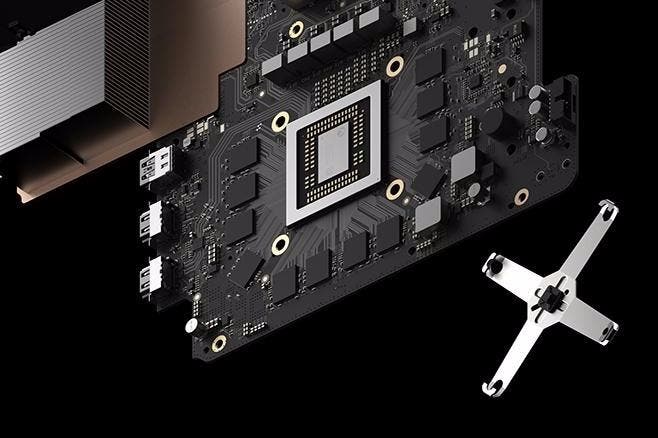We watched a Scorpio console get put together
Microsoft shows Digital Foundry how it's building the next Xbox.
The big surprise of my first Project Scorpio tech briefing? That's obvious: the fact that Microsoft has managed to push GPU frequencies all the way up to 1172MHz - far higher than anything we've seen from any current-gen console. When the silicon architects first revealed this spec point, I wondered how the hardware team had managed to achieve desktop PC-level GPU clocks in a console-sized form factor. "You've not seen the form-factor yet," replied Microsoft's Kevin Gammill wryly.
Heading the second briefing in a packed day is Leo Del Castillo, General Manager of the Xbox Hardware team, responsible for overseeing every piece of Xbox hardware and peripheral the firm has produced.
It takes a few minutes for me to fully register what's happening as the meeting progresses, but he's essentially building a Project Scorpio console right in front of me. From processor to motherboard to chassis to final form-factor, the building blocks of a retail console are slowly come together as the briefing continues.
Of course, it starts with the Scorpio Engine itself - six teraflops of processing power, seven billion transistors, packed onto a 360mm2 slice of silicon. However, for Del Castillo and his team, they're creating surrounding elements of the console before the processor even exists in physical form.
"From the very first day, our silicon engineers and architects are figuring out what the actual silicon is going to do," he says. "My electrical engineers, my mechanical engineers are working out how they're going to bring the signals out of the silicon onto the motherboard, how the board's going to fit into a chassis, the designers are figuring out what the configuration of the outside's going to look like. All these things kind of have to happen simultaneously. If they don't, it becomes a very serialised process and you won't end up with a very optimal product. [It's] a lot of engineers from lots of different disciplines, all iterating and eventually converging on a single design."
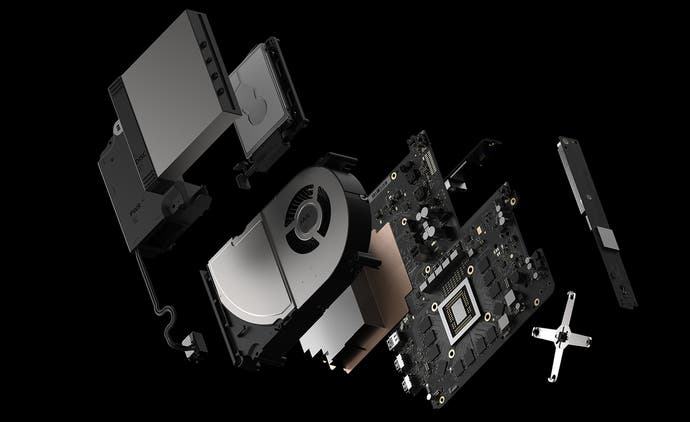
Under the desk in front of me, Del Castillo has a stash of Scorpio components and he pulls out the processor itself. It's the first time I've seen it, and in fact, it's the first confirmation I have that Microsoft possesses production silicon.
"This is a 50x50mm package that has 2400 balls on the back side for power and signals," he says, turning the processor over, pointing to the contacts at the edge of the package. "These are variable pitch. If you look, some of the balls are closer together than others. The smallest pitch on this is 0.8mm, which we believe is the tightest pitch large package of this kind being used today."
The SoC (system on chip) is the brains of the Scorpio console, but in isolation it's little more than an 'inanimate object', as Del Castillo calls it. The heart of the system is the motherboard, the next component brought out from under the table. It's small, very small. Consoles have gradually become more integrated over time - a function of multiple processors all integrating into a single SoC. The motherboard reduces in size as a result, but at this point I do start to wonder about the form factor of the final machine and just how compact the production unit is.
"The motherboard and the mechanical structure go very much hand in hand," explains Del Castillo, pointing to the external ports that will end up on the rear of the console, once fully assembled. "The IO for instance - we laid out the IO to be very much the same as the Xbox One S, so the order of the ports, the position of the ports are basically the same. Even the cables. You can take the power cable and HDMI cable [from Xbox One S] - they're the same part number from us, directly interchangeable."
The Scorpio motherboard uses eight layers - two for power distribution around the system and the rest for signals. Signalling around the SoC looks packed - this is the 384-bit memory interface meshing with 12 surrounding 1GB GDDR5 modules running at 6.8GHz. According to Del Castillo, this is a hand-tuned bus.
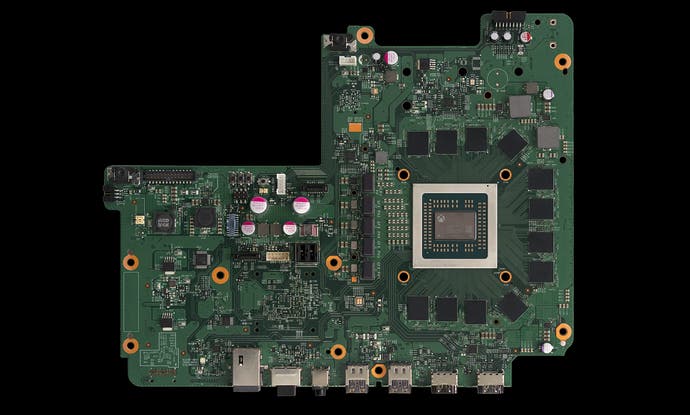
"This bus is very finely tuned to meet the performance requirement and get all the performance out of the chip," he explain. "These buses are operating very, very quickly. It is amazing to think about it, but signals travel at the speed of light, right? The time it takes for a bit of information to get from the memory to the SoC, two more bits will join it on that same piece of copper. There's over a thousand pieces of information in flight on copper on this bus at any given time when it's operating at those kinds of speeds."
In order to maintain power efficiency, the CPU, GPU and memory components can run at different speeds, according to system requirements.
"The number of power states we have in the SoC - the Scorpio Engine itself - is eight CPU states, five GPU states, three for the memory," Del Castillo reveals. "Naturally all of those will be maxed out if you're playing a high performance game, but for other modes of operation you want to minimise the amount of power the system is consuming. It's better for the environment when you use less electricity to power the box and it minimises the demands on the thermal system, and you can run the fans as slow as possible... when you're watching a movie [or] watching television through your HDMI, or when you're doing something that doesn't require all of the performance. You can scale all of that back and make the system much more efficient that way."
Power delivery is handled via five VRMs - voltage regulators - that sit to the left of the Scorpio Engine on the motherboard. There are 15 interconnected power rails for this particular interface.
"Between trying to target a compact design, and also strike overall efficiency and minimise power use, we do a lot of things that are special," Del Castillo continues. "One of the things we do is we basically fine-tune the voltages for each of the chips and optimise them so the chips are getting exactly what they need to get the job done."
As we've mentioned previously, this is a technique that hasn't been deployed on a console before - to the best of our knowledge, at least. It's called the 'Hovis method', named after the Microsoft engineer who devised the concept.
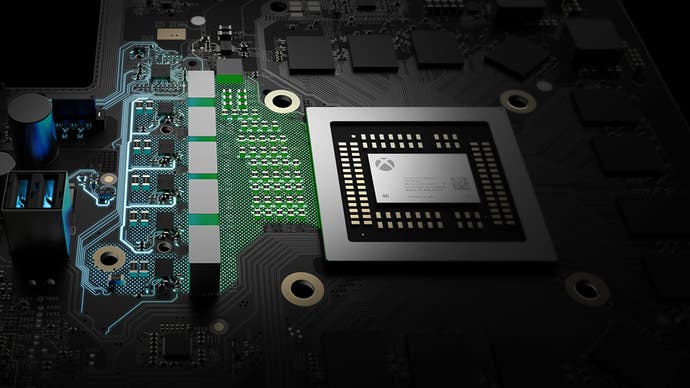
"It's not new technology in that chips have differences in settings and things like that. What is really different is that this is almost like taking the chip to a dyno," Del Castillo says. "If you're familiar with cars, cars get tuned on a dyno. We tune everything at the motherboard level, rather than the component level. It takes into account a lot of variations in other parts that are sitting alongside those boards.
"Another analogy I would use is that you can buy a suit off the rack - a 44 regular or whatever size you are, or you can go to a tailor and have the suit fit specifically, right? That's kind of what we're talking about. That drives a much higher degree of efficiency into the system and allows us to get rid of a lot of wasted power that would otherwise come out as heat."
"It ties back into the craftsmanship of the whole thing," adds Francine Shammami, Xbox Senior Engineer. "We were really proud of this design... We put that craftsmanship into it from the inside out. Every single motherboard that comes off our line has this individually tuned voltage setting. We're really proud of it. It's something the team has being wanting to do for a few years. We're really excited to be doing it on Scorpio."
The motherboard attaches to the chassis, a drawn piece of steel that combines with a second part, forming a protective shield for the internals. These provide the backbone for the system in terms of its rigidity, but also protects the user from electromagnetic emissions. This part of the design should look very familiar to anyone who has dismantled a prior generation Xbox. With the motherboard attached to one of the steel surrounds, Leo begins to add in additional components. It starts with the hard drive. Microsoft promises a 50 per cent increase in bandwidth here, and that means cherry-picking drives that meet this specification.
"True 4K gaming was going to require a lot more data in the form of higher definition textures. One of the things we really worked for was to improve the performance of our mass storage system," he says, slotting the HDD into place - but there's something different here. The drive itself sits upon a more elaborate assembly than anything I've seen in a console before.
"No matter how good the part is, it's this integration with the rest of the system can make a lot of difference. One of the things that really hits its performance is vibration. Vibration is like the enemy of streaming speed. It raises error rates and creates latencies and makes the drive spin down. One of the things we do is we take the drive and we suspend it on elastomer dampers. Those absorb a lot of the energies that are borne through the chassis from other parts, like the fans, the optical drive spinning around."

Leo points to a very small, almost irrelevant-looking plastic bracket next to the hard drive assembly. Immediate impressions are that this simply tidies away an already very short cable but its overall function is more important than you might think.
"Its purpose in life is to keep that cable pressed down and out of the way, because otherwise it might arc up and touch the chassis above it, again transferring vibration," he says. "These are all things we learned from building consoles for as long as we have. It's that attention to all these engineering details that makes sure that we get all the performance out of the components that we use and that the customer gets the best experience possible."
Keeping the system cool is the key challenge for Scorpio: the processor consumes more power than any single part in any previous Xbox and even with the innovative power management system, it still kicks out plenty of heat - as do the voltage regulators. Moving to GDDR5 over Xbox One's DDR3 also represents a big increase in power consumption. With these factors combined, more innovation is required in the new console's cooling assembly.
"We're really looking for the optimum solutions," Del Castillo confirms. "So one of the things that we've done is gone to a vapour chamber solution for our heat sink. Vapour chambers, basically it's a copper vessel that forms the base of the heat sink inside of which is deionised water under vacuum. Vacuum helps the boiling point of that water to be lower."
The cooling assembly is impressive - the heat sink has a low profile, and the entire base plate is constructed from copper. It covers a good proportion of the motherboard's right side, sitting atop the Scorpio Engine, the VRMs and the clamshell arrangement of GDDR5. The standard axial fan solution found in prior Xbox hardware wouldn't cut the mustard here, so Microsoft has paired the vapour chamber heat sink with a blower-style centrifugal fan, which Leo brings out and places on top of the heat sink.
Ducting here is extensive: cooler air comes from the sides, with hot air blown out the back. Aside from the cooling advantage, there's a user convenience angle too - you can place another box on top of the Scorpio console and it won't block the heat exhaust.
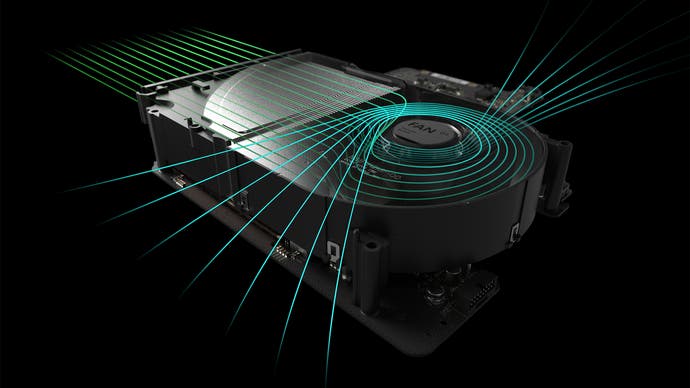
"We went to a custom designed adapted centrifugal fan for this design. It kind of looks like a super-charger on a car, it looks like an intercooler almost," says Del Castillo. "Every part about this is custom designed for the application. The vapour chamber heat sink is configured, the design of the impellers and the ducts... we started off with computational fluid dynamics models. This is again part of the concurrent engineering approach we take even before we have final silicon designs and final motherboard designs."
Again, this is all created in parallel with other components in the system way before final parts are fabricated, to the point where initials models of the chassis are built with heaters in place of electrical components to simulate the cooling challenge ahead. What I didn't get to see was the cooling assembly in action - and fan noise has been an issue this generation, on PlayStation hardware especially. However, Del Castillo does explain how the algorithm for operating the fans works. There are 32 diodes on the SoC, required because the different power states for different elements of the chip cause varying degrees of heat generation across the die.
"We have 32 diodes on that die and we track them all the time, but for Scorpio we had to go to the next level," adds Andres Hernandez, Xbox Senior Electrical Engineer. "One of the things we did for that is track the power on the Scorpio Engine. That allows us to do very deterministic operations on the fan so we go figure out the Scorpio power and then we can determine the exact TJ temperature that we can run that chip at. So that's something that is really cool for Scorpio. Determining that TJ allows us to run the fan efficiently, so that's part of the algorithm that is new for Scorpio - and then we serialise all of these inputs into several PID controllers that end up controlling that fan speed."
Ducts on the cooling shroud cover the vapour chamber heatsink, but there's also another duct for the next component that slots into place - the internal power supply. This became a standard on Xbox One S and the positive reception from consumers ensured that it carried over to Scorpio. Del Castillo says that the new 245W unit is the most efficient power supply used by an Xbox console to date.
"With that we have just a few more pieces left," he continues, pulling out another box that slots into place within the Scorpio chassis. "So, Xbox One S today is the only game console that is capable of UHD Blu-ray playback, so the optical drive that we optimised for Xbox One S fairly fits this application. We made some small tweaks to the way it integrates with this chassis but other than that the drive is unchanged."
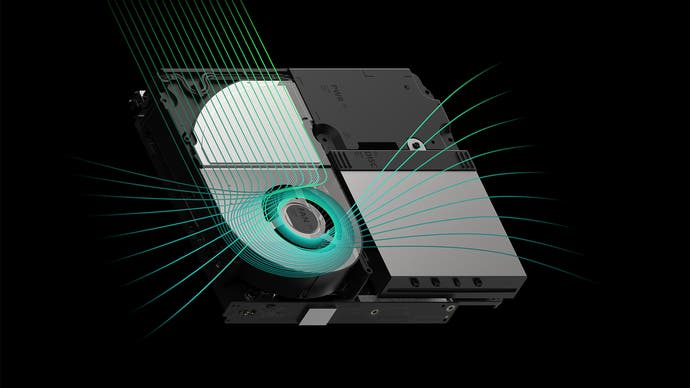
And with that, the collection of console internals is complete. Everything is tightly packed, there is no wasted space. Having dismantled a fair few Xbox consoles in the past, this level of integration is on another level compared to prior Microsoft boxes. The second half of the steel chassis slots into place, and Del Castillo points to a row of holes at the back of the unit. On the face of it, it's an incidental detail and yet even here, a lot of work has been poured into the manufacture of the unit.
"One of the things we needed to do was to find a way to punch large holes that would allow a large amount of air to pass through and look fairly transparent," he explains. "These holes are punched very, very close together - so close together that the webbing between the holes is thinner than the thickness of the material. Before we did this, if you asked any tooling engineer if this was possible they'd say no, it should not be done, it should not even be attempted. But our engineers took that as a challenge. So those are punched holes, punched in a metal press, not cut with a laser. They're perfectly straight and at a very high aspect ratio. All this attention to detail allows us to optimise our overall design and get all those pieces in there."
Finalising the construction are the WiFi and Xbox wireless radios, again derived from Xbox One S and moved on into Project Scorpio with improved iterations. Customisation was required to integrate with the new chassis, but the core specification remains unchanged - meaning that the 2x2 WiFi accommodates the 802.11ac dual-band standard at both 2.4GHz and 5GHz. And with that, an almost complete Project Scorpio unit sits in front of me, lacking only what Microsoft calls the ID - the final exterior plastics. All I'll say here is that when Microsoft reveals the box at E3, you should go in expecting surprises. Pleasant ones.
It's always interesting to see console teardowns once the likes of iFixit get hold of final retail consoles - but this presentation is unique in that I actually got to see the reverse: the unit was put together right in front of me with an outline of the engineering processes involved in the design. What's fascinating here is that while the technologies in play are state-of-the-art, there is still a simple elegance in the modularity of the design - and it's here where you can see similarities with prior Xbox designs.
The question of how Microsoft has managed to extract desktop GPU-like clock-speeds from a console SoC, and by extension, how the Xbox team has delivered six teraflops of GPU power, is now answered. The end result is a 43 per cent increase in raw compute compared to PS4 Pro, with a processor we estimate as being 12 to 16 per cent larger in terms of die area.
That's an impressive accomplishment and clearly, achieving it was far from easy. From my perspective, the only unknown is just how discrete and quiet the final hardware will be - and just how much additional cost the choice of components adds to the base price. In common with all the outstanding questions we have, this is a matter for E3 and we'll report back on that when we have more answers.
We learned about Project Scorpio at an exclusive briefing at Xbox HQ. Microsoft paid for travel and accommodation.
